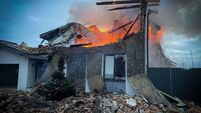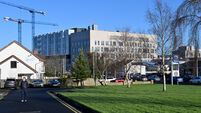Adi Roche: UN Chernobyl Remembrance Day is a time to think of our brothers and sisters

Maxim Shevchuk, the deputy head of the agency managing the Chernobyl exclusion zone, pictured on April 16 at a building that had been occupied by Russian troops near the ruined nuclear power plant in Ukraine. Picture: Efrem Lukatsky/AP
On this UN Chernobyl Remembrance Day, I am reflecting on the devastating tragedy that is unfolding in Ukraine these past two months and how Chernobyl has re-entered centre stage.
Thirty-six years ago, on April 26, 1986, a suffering unleashed at 1.23am, in a little-known nuclear reactor in northern Ukraine. A new word, “Chernobyl”, entered the history of language, the history of world disasters, and into history of the world itself, with a terrible and frightening force.
On that fateful morning, the nuclear reactor in the Chernobyl nuclear station exploded, spewing 190 tons of deadly contaminating radiation 7km into the dark night sky and then carried by the prevailing winds northwards.
The horrific invasion of Ukraine is evidence that Chernobyl remains an unfolding disaster.

On February 24, 2022, the nature of modern warfare changed forever, as the news came cascading into our homes that the Chernobyl nuclear plant and exclusion zone had been invaded by Russia. Thousands of Russian troops arrived at Chernobyl in trucks and personnel carriers and other deadly war-making assault weapons.
This cavalier act, the taking over of the entire reactor site and exclusion zone was akin to making a deadly nuclear threat without making a verbal nuclear threat, and the world was essentially held to ransom.
Russian troops ran rampant through the reactor facility and its surrounding buildings, looting and damaging everything they could find.
Despite warnings from the staff at Chernobyl, young troops entered the nearby highly radioactive forest, known as the Red Forest, without any respiratory protection or protective clothing, and dug fortification trenches, tank shelters, command centres, and underground kitchens throughout the most radioactive ground in the world, whilst unearthing some of the hundreds of nuclear grave sites containing deadly and highly radioactive material buried from the 1986 disaster.

Subsequent reports state that five busloads of Russian soldiers suffering from radiation sickness were taken to a special radiation centre in southern Belarus.
The Russian soldiers looted and destroyed an EU radiation monitoring facility. There is serious concern regarding stolen radioactive material such as small instruments, taken as souvenirs, that appear harmless to the uninformed soldier — but such instruments may cause radiation burns to the skin in as little as two minutes.
During the occupation of the exclusion zone, several fires erupted in an expansive area throwing up into the air radioactive dust previously locked in the land. Scientists working in the region are deeply concerned that any disturbance of radioactivity is potentially lethal, as it re-releases radioactivity into the atmosphere.
As confirmed by the International Atomic Energy Agency, the situation in the area around Chernobyl “remains difficult” due to roads and bridges in the surrounding areas being blown up and completely destroyed.
There is no guarantee that Russian troops will not return to Chernobyl.
There may be an impression that Chernobyl has been relegated to the past and no longer poses a threat to the world, but the reality is different. Chernobyl is not something from the past; Chernobyl is, sadly, forever.
The impact of that single nuclear accident can never be undone; its radioactive footprint is embedded in our world forever and millions of people are still being affected by its deadly legacy. The besieged region of Ivankiv in the Chernobyl zone was recently liberated by the Ukrainian army, but this good news was overshadowed by another threat as citizens are now faced with a huge rise in radiation levels.
Having emerged from bunkers after five weeks, scientists have now discovered an alarming rise in radiation following the military activity in Chernobyl.
Expert scientist on all matters Chernobyl, Yury Bandazhevsky noted that the disturbance of the soil from tanks, troops, and shelling has led to elevated levels of radioactive long-lived radionuclides (Caesium 137, Strontium 90, and Americium 241) on the clothing and bodies of people in this highly populated area of Chernobyl.
Professor Bandazhevsky is calling for “an immediate evacuation of the most vulnerable” to clean land in Ukraine in order to save the victims of the “first” war from this now potential “second but invisible war”.
This is exacerbated by the zone being mined and heavily trip wired. The radioactive soil spewed up into the atmosphere will damage the innocent people living and farming in this area.

As in most tragedies, children pay the highest price. Their small bodies absorb adult doses, and the consequences are potentially lethal.
The war that has been waged by the invasion of Chernobyl is a silent, invisible but deadly one. No smell, no sight, nothing to forewarn you of danger. Yet it beats in the hearts of every innocent man, woman, and child, in all living things... from human beings to animals, flora and fauna.
It beats in their rivers, towns, streams and forests. The deadly radiation, clicking endlessly, ferociously in Geiger counters into the silent numbness that is, and sadly will always be, Chernobyl. I dread to think that the next Chernobyl could be Chernobyl itself.
Today on this 36th anniversary of one of the darkest days in human history and human tragedy, in this time of terrible war, in this time of fleeing refugees, let us also rage against the dying light of hope, the dimming light of not enough done, of neglect, of forgetfulness, of abandonment, indifference, and the distraction of other disasters.
Today, we renew our commitment not to give up, not to stand idly by, but to stand up, speak out and give witness and be at the frontline of humanitarian aid.
Today, let us renew and rekindle our commitment to the innocent victims of Chernobyl, those ordinary people, their lives, their hopes, their homes, their security, their safety, and say to them once more — you are not forgotten. You are not irrelevant, you are not peripheral, we will do our utmost to care for and protect you.
We are your brothers and your sisters.
Your pain and suffering is ours, offering that most precious and enabling gift of hope, and so, we relight the beacon of hope in the “heart of hope”, and let the light flash around this world.

But especially let it fly to the dear people of Ukraine, to say to them the flame is not quenched, the beacon is still alight, gather near and gather strength from its light. You are not forgotten. You are not alone.
You are among friends and neighbours who care. Not with just fine words but with positive and life changing initiatives of action, for there is always hope!
Today, we remember the Irish proverb, Is ar scáth a chéile, a mhaireann na daoine, meaning “we live in the shadow of each other”.
• Adi Roche is the founder and CEO of Chernobyl Children's Project International
















